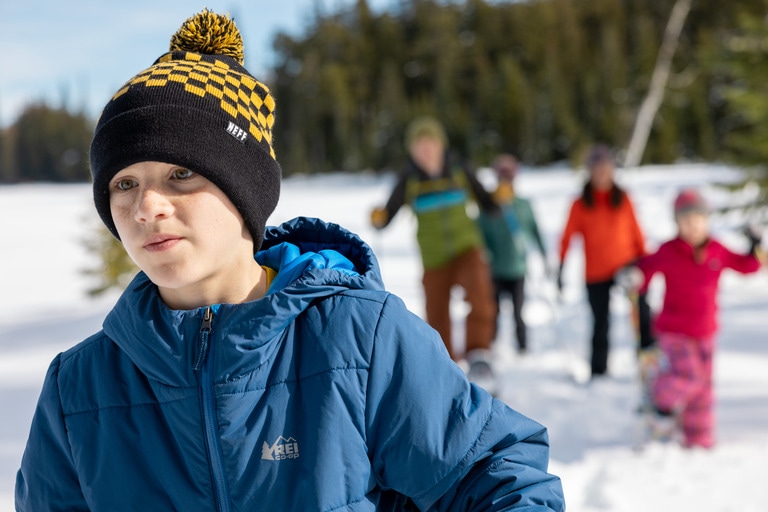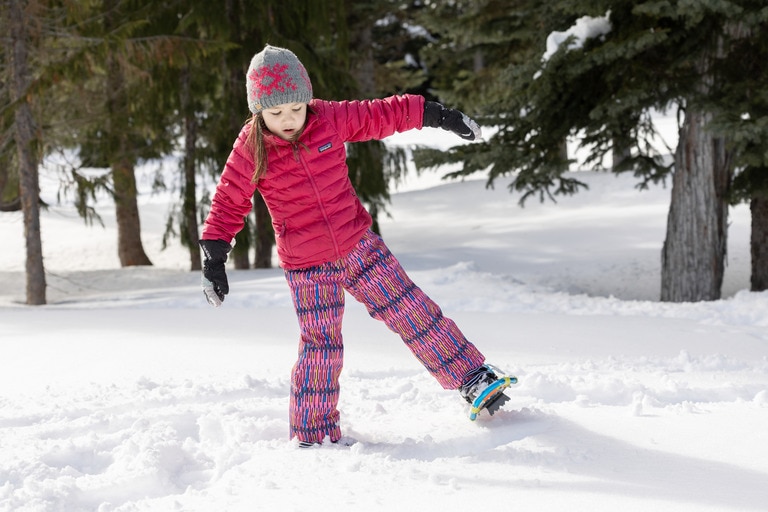Polar bear parents have it easy. Their cubs have a natural fur coat, so they're always ready for fall and winter. We human creatures, though, have to bundle our kids up for cold weather. In this article, we'll cover the types of winter coats and pants that are out there and help you decide which ones are the right choices for your child.

Types of Winter Coats and Jackets for Kids
Insulated jackets: A jacket with an insulating fill is your warmest option, and choosing one involves deciding between down and synthetic insulations. For a detailed comparison, read Down vs. Synthetic: Which insulation is right for you?
- Down jackets: Naturally derived, down offers unrivaled warmth; jackets made with it are also lightweight and easy to pack. Wet down doesn't offer much warmth, so you should look for (more expensive) water-resistant down if you're worried about wet conditions.
- Synthetic insulated jackets: More affordable than down, synthetic insulations offer warmth even if they get wet. Some of the best synthetic jackets are close to down in warmth, but also price.
Fleece and soft-shell jackets: Soft, warm and affordable, fleece jackets work as a middle layer to provide a moderate amount of warmth. Unlike insulated jackets, snow jackets and 3-in-1 jackets, they don't protect against rain or windchill—so your child will need separate rain gear for those conditions. Soft-shell jackets, which combine lightweight insulation with a little rain and wind protection, offer comparable warmth to lightweight fleece jackets.
Snow jackets: These insulated coats (almost exclusively with synthetic fill) have at least one or two features that make them appropriate for the slopes: snow skirts, pass-holders, goggles pockets, etc. Most will also be waterproof/breathable, so they can double as rain gear in colder conditions.
3-in-1 jackets: These jackets combine a rainproof outer shell (most have waterproof/breathable fabrics) with an insulated liner. The liner jackets might be made of fleece, or have an insulating down or synthetic fill. The most versatile outerwear option, it allows kids to wear each piece separately or both together.
Casual jackets: This is a catchall term for a less rugged or technically sophisticated alternative to a jacket in one of the other categories.
Rain jackets: Even though a lot of insulated jackets also provide rain protection, your child also needs a separate rain jacket in certain instances. In windy or rainy weather, kids need to have a rain jacket to wear over a fleece jacket. If a child's insulated jacket is merely water resistant rather than fully waterproof, then a rain jacket can offer added protection in a deluge. For a full discussion of kids' rainwear, read How to Choose Kids' Rain Gear.
Winter outerwear for infants: Snowsuits are your warmest option. Warmth and prices vary, ranging from icy-weather styles that have an insulating fill to moderately priced fleece bunting that can work on cool days. Most suits have a long zipper to make diaper changes easier. Also look for foldover cuffs that help keep hands and feet covered and warm.
Winter outerwear for toddlers: Many snowsuits come in toddler sizes, which makes them the warmest, most protective option for kids who are still in diapers. Once kids are potty-trained, though, full-piece snowsuits are less convenient. Bathroom breaks require quick action (not a full-scale suit removal), so you might prefer separate jacket and pants at that point. And, even though it can be harder for kids to toddle around in extra-puffy garments, don't trade warmth for mobility.

Types of Winter Pants (Outerwear) for Kids
Kids' winter pants are made of much the same stuff as winter jackets, but the categories can be boiled down to three warm options, plus rain pants for wet, windy conditions:
Snow pants: Just like an insulated jacket, snow pants feature a wind- and water-resistant or waterproof shell with an insulating down or synthetic fill inside.
Snow bibs/overalls: These are a warmer alternative to insulated snow pants because they come up higher to provide more core warmth. They also extend coverage, helping to keep out wet, slushy snow when a kid takes a tumble or decides to roll around in the snow. They're more cumbersome to remove for bathroom breaks, so newly potty-trained kids might be better off with traditional snow pants.
Fleece pants: Like fleece jackets, these offer a moderate amount of warmth for cool days. They won't protect during a steady rain or wind, so you need to add rain pants in drizzly conditions.
Rain pants: If your child's winter pants are fleece pants, then you need an outer layer of protection when the weather turns rainy or windy, or both.
Features to Consider in Kids' Outerwear

Jacket length: The longer the jacket, the more warmth it provides. Most jackets are waist length or hip length.
Hoods: You'll find similar designs and adjustment features to hoods on adult jackets, except that jackets for toddlers and infants have elastic for simplicity and safety, rather than drawcord and tab adjustments.
Cuffs, waists and hem closures: Elastic closures, found on items for infants and toddlers and older kids, help seal in warmth without the fuss of adjusting drawcords or cuff tabs. Drawcords are also prohibited by law because they can be a hazard. Adjustable cuff closures, which are not prohibited, will do a better job of sealing out cold air.
Thumbhole cuffs: This handy feature lets kids use thumbs to pull sleeves down over their wrists for more warmth and coverage. Found primarily on fleece jackets and the inner jacket in 3-in-1 style outerwear, thumbholes keep inner jacket sleeves from riding up when a child pulls on an outer layer.
Snow features: You can get your little shredder snow pants and jackets with many of the same features as adult gear, like snow skirts, reinforced cuffs, snow pass holders and more. For the occasional sled run or snowball free-for-all, any waterproof insulated outerwear should work fine.
Extendable sleeves and pant legs: The exact name each brand uses differs, but this feature allows you to extend sleeves or legs by 1.5 to 2 inches to get an additional season of use from a jacket or pair of pants. You can also buy items a half-size large, but there are a number of drawbacks. Pants that are too long have to be hemmed. Ill-fitting gear simply doesn't perform as well. Or your kid might have a major growth spurt that forces you to buy new stuff anyway.
Adjustable waist tabs: Similar to extendable sleeves and pant legs, fit adjustment tabs on the waistbands of most insulated pants help accommodate for kids' growth and variability in waist sizing.
Glove leashes and ID labels: Kids aren't always so great at keeping track of their stuff, so look for features that help do that for you.
Reflective accents: As darkness sneaks into morning and evening hours, reflectivity becomes more important. With today's technology, all it takes is a little reflective logo or piping on a jacket to make it very visible when a pair of headlights sweeps across it.
Additional Tips for Buying Kids' Winter Outerwear

Consider the strategies below as you shop for your child's winter wear. They can help narrow down your choices and extend the comfort range of the gear you get.
Buy for your climate: Parents in the Pacific Northwest, for example, experience lots of rain, so moisture management is a key. Synthetic insulations that handle moisture well make sense. Waterproof outer shells that are also breathable are worth the added cost. In cold, dry climates like northern Minnesota, for example, kids need to be ready for severe cold. Super-puffy down jackets make sense, and insulated mittens for little hands are also important.
Consider your kids' activity levels: If your kids will be going with you on a cold-weather hike, for example, they'll generate warmth continuously, so less puffy, less bulky jackets and pants work. That changes in stop-and-go situations like on a sledding hill, where trudging uphill is interspersed with standing in line and scooting down. In that scenario, a heavier insulation will help maintain warmth during the downtimes.
Don't shop by temperature ratings: Many variables affect warmth. Kids have different metabolisms, and weather like wind and rain dramatically change how much body heat a jacket retains. We don't provide temperature ratings on jackets and pants at the REI Co-op for these reasons; you might see temperature ratings on kids' clothing elsewhere, but we don't recommend you rely on them. (They may be helpful for comparing the relative warmth of two jackets of the same brand, however.)
Plan for layers: You can help your child stay warm by employing the same outdoor strategy you use. Start with a wicking base layer, then mix and match with other layers to adapt to changing conditions. Be sure the outerwear you're buying is large enough to accommodate these extra layers. For a more in-depth look at how to layer clothing, read Layering Basics.
Don't forget the accessories: Kids' heads, hands and feet get cold quickly, so be sure they have a warm hat and mittens or gloves to wear. Thick socks, along with some winter boots or rain boots, are also important. Some parents buy their kids lightweight, waterproof hiking shoes, figuring they'll be sturdy enough for everyday wear and prevent their need for galoshes.
Make sure everything fits before you need it: Few things are more baffling than kids' sizing. And brands vary widely in the way kids' clothing fits. Read How to Dress Your Kids for the Outdoors to learn more about kids' sizing. Then, whether you buy items in store or online, try everything on as soon as you get it home. Don't wait until the first snow flies to find out things don't fit properly.
